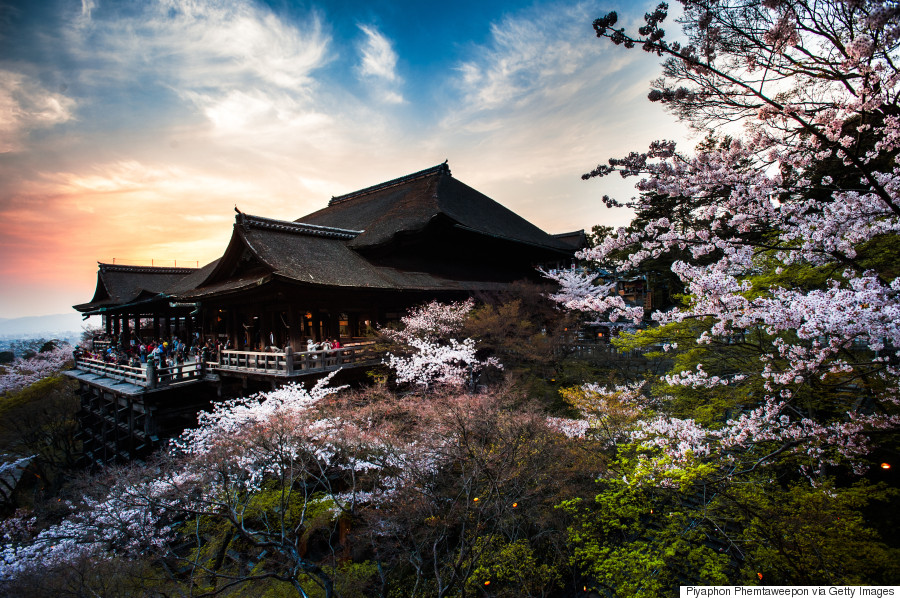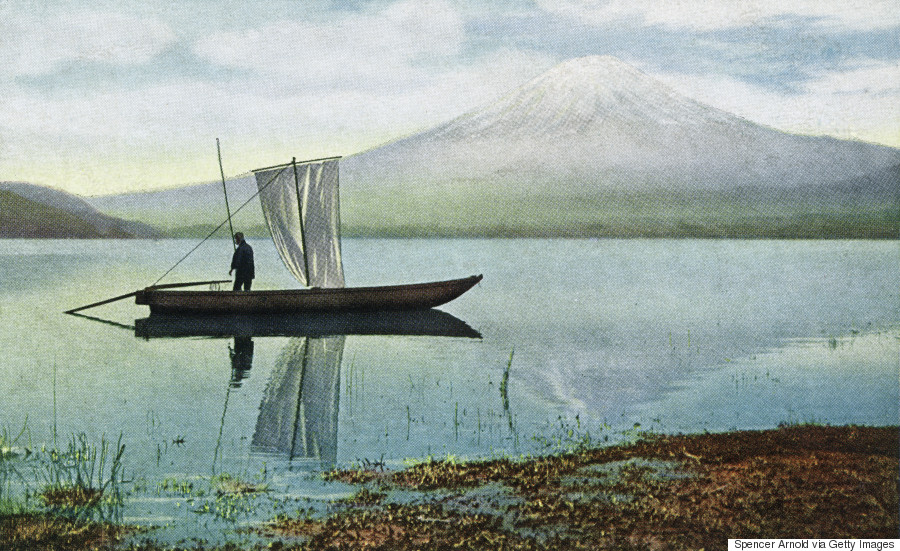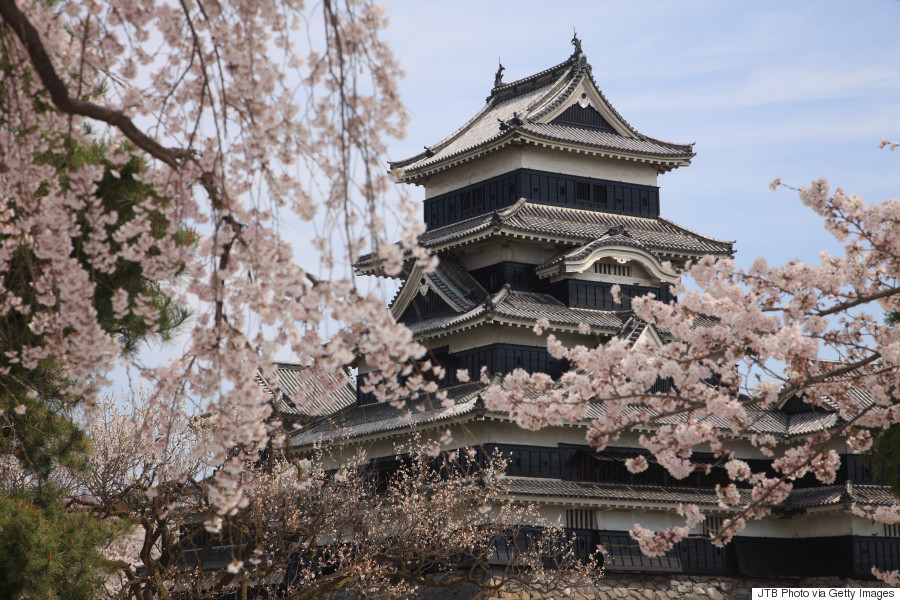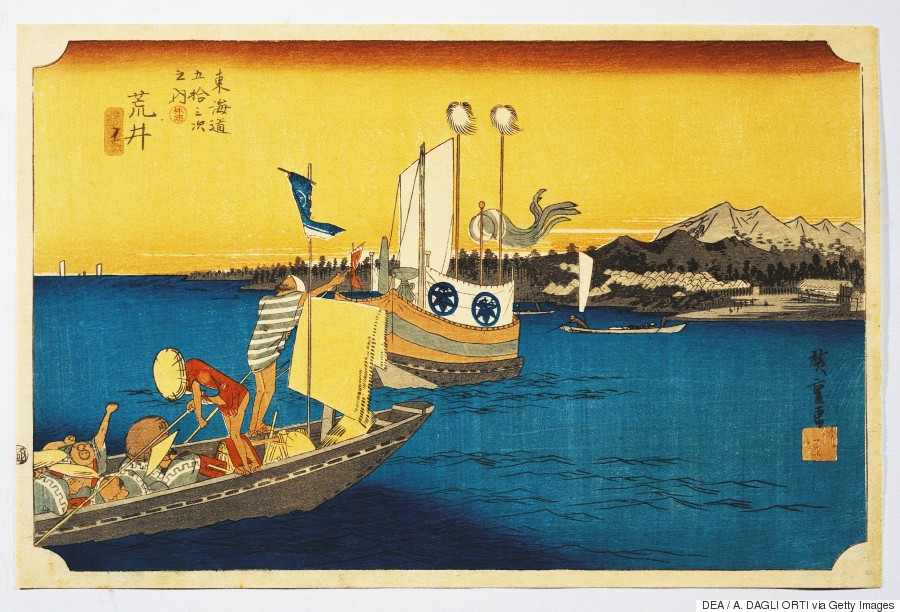The Disappearance of Self in Japan

You’re drifting in a rowboat on a quiet pond. Another boat bumps against your own and jolts you out of your self-forgetfulness.
You stand up in a rage, and start berating the negligent rower in the other boat. Then you notice that it’s empty. There’s no one to blame (save circumstance or the current or the boat itself), so there’s no one to be angry with. You sit down again and realize that, if there’s no target for your tirade (except yourself), there might as well be no tirade.
You wonder, perhaps, why exactly the same event can trigger such different responses in you if there’s a human in the boat or none at all. The bump on your vessel and the shock and the possible injuries — they’re all the same. But your response is as different as a stormy day is from a mild one.
The trick in working with life, rather than against it, as a student of Zen might say, is to realize that there’s nothing personal in anything. Or, as the singer-poet Leonard Cohen puts it in a late song, composed after five and a half years as an ordained Zen monk, “None of us deserving / The cruelty or the grace.”
The cure for every suffering lies in the mind, in that part of the mind that sees that the self is as fleeting as a reflection on water.

I’m neither a philosopher nor a Buddhist, so everything I say here should be shadowed by an asterisk, noting how provisional and ill-informed it is. The example I just cited, after all, is a well-known Taoist parable. But 28 years of living in Japan have taught me how very different the notion of the self is there (and perhaps across East Asia) from the one I grew up with in England and the U.S. Twenty-eight years have also taught me how difficult it is to say how much Japan is a product of Zen (which, after all, came from the Chinese Chan tradition) and how much Zen is a product of Japan. Whatever the answer, the fact remains: 70 percent of all Japanese written sentences, by one count — and 52 percent of spoken ones — lack subjects. And much of even its revved-up, Western-seeming, dizzyingly material society in the 21st century seems to be governed by the simple precept of a Zen teacher: “less self, more compassion.”
(Which could be extended to “less self, more fulfillment.” The more you’re emptied out, runs the logic of Kyoto, the more you’re ready to be filled up).
To get self out of the equation — if only so as to be part of something wiser and more enduring — seems the goal of most religious traditions. There are schools of thought, and often worthy ones, that stress that God must be in the self, if anywhere, and thus the aim of life is to recover or awaken the divine within; but even that suggests that there are many more impermanent and less exalted things within from which the divine has to be sifted.
“The Ego … is like a man who will stand right in front of you at a horse race,” Christopher Isherwood wrote in his journals, after embarking on a 40-year study of Vedantic Hinduism. Isherwood could never quite get rid of himself as he would have liked, but he could see that the more he did so, the happier he was. As the brilliant and unsparing Jewish-Christian philosopher Simone Weil had it, “The sin in me says, ‘I.'” As she went on to say, with her customary lack of qualification, “Nothing in the world can rob us of the power to say ‘I.’ Nothing except extreme affliction.”
‘The Ego … is like a man who will stand right in front of you at a horse race.’
Most of us are keenly aware that there are many other things that release us, if only for a moment (and a moment that can feel like a piece of eternity), from the “‘I”: the birth of a child, an act of love, deep absorption in a piece of music or a film or a book, the magical liberation that can come from being lost in a landscape much vaster and less temporary than we can be. The reason people so eagerly line up on benches to watch the sun set surely has something to do with the communal emancipation of giving oneself over to a larger cycle.
But Weil’s unflinching affirmation of self-mortification does have a Zen sound. Stay up for seven days and nights, give yourself over to a back-breaking physical discipline — scrubbing floors or sweeping leaves, as if in a Marine Corps parade ground crossed with a prison camp — and you do at some point lose your mind. And losing your smaller mind, certain Zen teachers will tell you, is the best way to lose your self. Or at least that divisive, analytical fixed self that sits outside of things and chops them up, as opposed to the fluid one that finds its identity in getting submerged within a larger stream. As the late German-born Zen teacher Toni Packer had it, “Ego, in its most general terms, is resistance to what is.”
Mind — in its tiniest form — is what comes between us and the world around us. And mind, many have said — since the Stoics and before — is what projects our imperfect longings and understanding onto reality. It’s not events that undo us, it’s what we make of them. It’s not that car accident, the forest fire, the dark diagnosis that brings pain, but the way it plays out in our heads (of course, the car accident may bring acute physical pain — mind can’t always rule over matter — but to some degree our mental training is what defines our response even to the disabilities of the body: as the Dalai Lama often points out, a weak mind and a strong body will always leave you shaky, as surely as a strong mind and a weak body may leave you more or less okay even when in hospital).
To be free of our thoughts — which is to say, too often, our needless anxieties, our individual aspirations, our mistaken ideas about the world — is to be part of a whole much wiser than we are.
As D?gen Zenji, the 13th century founder of the S?t? school, had it in one of the essential distillations of the Zen tradition: “To study the Way is to study the self. To study the self is to forget the self. To forget the self is to be illuminated by ten thousand things.”

That’s the theory at least. But how does it play out in practice? In my quarter-century and more in Japan, I’ve been struck at how much the Japanese, following a tradition that may go back to Confucius or Lao Tzu, see the virtue of keeping the self out of things. This may be compounded by the fact that for so long they have had to share so little space with so many: the typical Japanese occupies a house with 117 square feet per person, less than a quarter of the space a typical American occupies.
Put another way, Northeast Greenland National Park, with a population of about 40, occupies a territory almost as large as France and Japan combined. In such a congested environment, you can survive only by getting yourself out of the way — and counting on everyone else to do the same. Many Japanese are as committed to being as self-contained, quiet and respectful of another’s space as their neighbors are, and anyone who has ridden a subway at rush hour in Tokyo will know how seamlessly (and silently) this works. Beyond that, the self-styled “Land of Wa” (or harmony) sees that each individual will be happiest if the whole around him is taken care of. Thus, many a Westerner is startled when a typical Japanese, meeting you, is less keen to assert herself or tell you what she thinks, though she’ll ceremoniously present you with a business card, than to find out what you think and like — the better to arrange herself around that.
As a result, perhaps, my Japanese neighbors seem unusually good at adapting themselves to circumstance — fire or nuclear meltdown, sudden earthquake or infidelity (to which the local response is nearly always “It can’t be helped”) — and unusually good at following orders (hence, perhaps, their celebrated brutality in war). It’s also what makes them, often, correspondingly weak at taking the initiative, or asserting themselves in front of a cause, a collective or a project. Taking the “why” out of things, they often seem to remove the “who” as well.
Mind is what comes between us and the world around us.
A Tibetan Buddhist, looking at Zen practice, may ask where the philosophy and psychology in it are; where is the complex exploration of “mind” and who or what is the self saying (or even feeling) if there’s no self? It’s all very well reducing yourself to nothing by chopping wood or carrying water — and then sitting in a silent meditation hall so long that your legs go dead (and your mind with it) — but how do you deal with all the poisons and the possibilities that the mind throws up? I’ve heard visiting Tibetan monks mock their Zen counterparts as “vegetables”; their cultivated mindfulness may take some of the complication out of life, but how can it put things into perspective? Where is the ability to check on the mind — or non-mind? And is not the person in great pain sometimes more self-enclosed than anyone?
The problems of consciousness are not solved just by dodging them.

When it comes to a sense of fixed or absolute self — and some might say there’s no absolute in Zen save reality — this all makes, of course, for a very strong sense of relational self. This is something every one of us knows to some degree: If we were to describe yesterday night to an old high school friend, a colleague, a mother and a spouse, we would — perhaps we should — use radically different voices and phrases in every description. As William James noted, “A man has as many social selves as there are individuals who recognize him.”
You have only to look at the White House to see a man whose upbringing in Hawaii and Kansas and Indonesia, with African blood, gave him an unusually large repertoire of voices and selves. As the equally mobile Anglo-Jamaican writer Zadie Smith notes in her brilliant essay, “Speaking in Tongues,” this liberating multiplicity of selves sometimes means a corresponding inability to plant a single self anywhere. In Japan, I would say, this is regarded as the norm (which in Japan means the ideal).
We in the West, especially in recent decades, are taught to “be ourselves.” Authenticity comes in acting and speaking as only you can act and speak. In Japan, the most considerate thing is not to be yourself. Not to impose your particular personality — and preferences and prejudices — on a situation. The ideal is to play a part — to be generic, in a way — and to perform the Platonic ideal of a convenience store clerk rather than complicate the matter by insisting on being Yukiko or Naohiko.
The Californian shopkeeper sweetens your interaction with her (she hopes) by confiding in you about her boyfriend problems, by telling you of how aggrieved she is to be at work today, by introducing herself as “Paula” and calling you “Pico.” Her Japanese counterpart makes you feel at ease by being as officially seamless and polite — as invisible as possible — and letting you go about your business as if you had just extracted your can of hot milk tea from a vending machine.
Why let her personality — or yours — come between you and reality?
A gross simplification, of course, and perhaps a romantic distortion to boot; that there are agonies in Japan, often to do with the self and its sorrows, is amply borne out by the more than 1 million hikikomori, or shut-ins, who never leave their rooms, and by the sobering fact that one Japanese takes his or her life every 15 minutes. Yet anyone who has been to East Asia has grasped, if only at an instinctive level, how many things, starting with the self, take on a different meaning and value there, so that the nature of your interactions is (it seems) more formal, more hierarchical, more stiff and (it is believed) friction-free, than in all-over-the-place India or Indonesia not so many hours away.
Many also notice that the cultures where tipping is unknown offer the very best service, which arguably says something about social obligation, a commitment to the whole or (what underlies both) a readiness to take self out of the equation.
Nothing’s personal, in both directions.
I’m often struck at how my Japanese neighbors probably know less about Buddhist texts and teachings than do my neighbors in California; they ritually head to the temple only when it comes to the ceremonies around death — the official burning of the self — and even though four in every five admit to pollsters to observing Buddhist funeral rites, barely one in five calls herself a “Buddhist.” Maybe the terms are not important? In any case, as in any culture, Japanese monks are as often the butt of jokes and suspicion — why are they asking so much money for a headstone? — as the object of reverence.
Japan’s commitment to the relational self is what keeps it ever further from the world at large. But it also keeps it flourishing on its own terms.
But Japan’s gift is for taking principles and turning them into a code of etiquette; for, in fact — rather like a Zen monastic’s — absorbing those principles they feel no need to articulate. Meditation, after all, is part of almost every culture in the world (one reason Tibetan Buddhists don’t see it as the essence of their philosophy); but not many cultures have developed a contemplative aspect as rich as in (often noisy, fluorescent, more than cluttered) modern Japan. People there may not consciously see the self as the source of suffering, but they do seem to see it, in the public context, as being instrument and subordinate to the needs of the whole. A culture of ideograms more than ideas is already rooted in the concrete and in action, a freedom from needing to look for explanations.
In many ways, Japan’s commitment to the relational self (laid down in Buddhist Nara and Kyoto, where I live, more than a thousand years ago) is what keeps it ever further from the world at large (some would say, from the possibilities of modernity). It’s what keeps the nature of self and daily life flat to the point of boredom. It has turned the country too often into something of a deaf-mute in the international sphere. But it also keeps it flourishing on its own terms.
Behind the shifting surfaces
In his book “The Geography of Thought,” Richard Nisbett suggests how what might once have been Buddhist (or Confucian) principles have become rules and habits in such cultures by summarizing what he and other cultural psychologists have found in their research. An American 6-year-old, asked to describe his day, tends to refer to himself three times more than does a Chinese 6-year-old. Shown a picture of a fish tank, Americans are apt to fasten on the biggest and most prominent fish, while Japanese viewers make 60 percent more references to the water, the rocks and everything in the background. English-speaking parents are given to emphasizing nouns and categories when talking to their children, Nisbett and others have found, where Korean parents are likely to lay stress on verbs and relationships.
If you want confirmation of this, look at a picture by Hiroshige, in the late 19th century, next to one by Rosetti — a distinction beautifully opened out in Orhan Pamuk’s exploration of the individuality of artists in the West and the commitment to a larger whole of artists in the East, as seen by someone sitting between them, in “My Name is Red.” The characters in Hokusai’s “36 Views of Mount Fuji” are deliberately flat, without character, almost archetypal; what matters is the larger harmony, the scene and the seasons that put them in place, so to speak. Read an ancient Chinese or Japanese poem, see a movie by Yasujiro Ozu, and you register the same. The emotion comes through more strongly because the individual characters don’t get in the way.

For me, as an everyday journalist and untrained observer, this all plays out in every other detail of my daily life in Japan. My wife comes home from her job and tells me about “Section Head,” as she always calls her. The fact that I don’t even know her boss’s name — and that she never uses it — takes some of the sting, the personal animus, out of the complaints that she makes, as every worker around the world will make. She tells me about the occasional visitations of “Leader,” and I do not begin to have a person to imagine. And always, instinctively, she will favor first-person plural over first-person singular.
Talking to her oldest friend, from high school, she still introduces herself by her family name — which she didn’t change when she married me — and, of course, traditionally in Japan, as elsewhere in East Asia, the family name is what comes first. There are not only (famously) different words for the private self and the public in Japan — tatemae and honne — but also more than a dozen different words for “I,” depending on whether a man is speaking or a woman, an emperor or a commoner, a friend or a colleague. There may not be quite as many words for “I” in Japan as there are for snow in some indigenous languages, but there are certainly enough to suggest that it’s hard to think of absolutes in the midst of so many fine gradations.
My wife, dressed in a heavy-metal t-shirt and leather jacket, and off to her job selling punky English clothes, will still refer to herself in the third person — as only women in Japan do — and will not use my name in conversation with a friend, but will say something like “Husband” or “Man of the House.” If she’s talking to Mrs. Suzuki, she’ll ask, “Mrs. Suzuki is okay today?” so as not to trespass or presume too much intimacy. If we go into a casual pizza restaurant together, the hostess will greet us with: “A table for two honorable godlike customers?” adding honorifics both before and after the word for “two customers.”
This is about formality and a way of keeping intimacy remote and ritualized, but it’s also about taking our individual beings out of the story. As most visitors note, the Japanese love wearing uniforms, even when in mufti, as it were. On weekends, they simply change from the name-tag uniforms of their jobs to the roles — of rockabilly musician or bandaged nurse — they play for fun, and are most themselves when taking on a part. If an elderly couple lack grandchildren to visit them on Sundays, they think nothing of turning to the Japanese efficiency headquarters to hire a pair of young actors to come and perform the role, crying, “Hi, Grandma and Grandpa!,” as if to underline the fact that their sense of identity is much more porous than ours (this accounts, too, for their openness to automation and to robots, as well as to the two-dimensional surfaces of cosplay).

The fact that Japan functions as a kind of orchestra, in which everyone plays her part in a collective score, has made it famously unreceptive to outsiders, who likely don’t share the sheet music. I used to get strip-searched every time I returned to my adopted home, on the grounds of looking like someone from a poor Asian nation. This role-inflexibility has kept women in their place long after a relative equality has arrived in other developed nations — leading, rightly, to a brain drain, with Japan’s bright, determined and energetic women joining Goldman Sachs and McKinsey. The island nation still doesn’t seem to know what to do with gays, or people who don’t fit the norm. Even in a Japanese temple, the one-size-fits-all anonymous black robes can’t conceal every difference between Yoko and Gary.
Sometimes the society around me looks like an impeccable walled garden, compared with the wide open desert of the far West. We all know about the order, the harmony, the stillness of a Japanese garden, where even the moments of imperfection — a stray leaf vivid on a path — are perfectly placed and controlled to awaken a quiet within. We all know the sense of possibility and freedom, and sometimes the loneliness, of the great empty spaces of the West. In one, it seems, Nature can be managed so that the self disappears within it. In the other, paradoxically, the elements are so vast that the self has nothing to hold onto and asserts itself more loudly than ever. Each treats the relation of freedom to limitation — and by extension of self to society — in radically different ways.
Yet when I think of the self, I always remember the time I drove up the California coastline, 24 years ago, not long after my home had been burned to the ground in a forest fire, leaving me with nothing at all, and stepped into a Catholic hermitage, though I’m no Catholic nor full-time hermit.

Almost instantly, I felt as if a lens cap had been taken off, and I was experiencing the world with a sharpness and immediacy I’d forgotten. I heard a footfall on the driveway outside my little, motel-like room as if it were an event. I picked up a book and felt myself so deeply inside the text — whatever text it was — that I might have been the book’s creator as much as its consumer. I went out into the simple walled garden beyond my desk, overlooking the Pacific 1,200 feet below, and the stillness was so intense, I could register every movement.
What had happened, I came to realize, was that I had left my self in the car outside. Somehow, through years of prayer and contemplation, the 15 monks who lived here had created a silence so active, so transparent, that it wasn’t hard to feel one was stepping into a clearer, larger realm. I’m not a mystic, but I did notice that all the agitated thoughts I’d had on the drive up — my guilt about leaving my loved ones at home, my anxiety about this deadline or that project, the arguments I’ve been carrying on in my head with Steve last night — had all dissolved.
This didn’t, I would find in time, make for good writing, especially in a world that defines itself through divisions. The peace in the hermitage wasn’t one I’d earned and in which I couldn’t afford to live full-time, as a writer. The lightness it gave me was a reminder and a way station, recalling to me how best to conduct myself in the world, in the direction that made most sense to me.
But feeling I could see something behind the clamor and congestion of the world, what is changeless behind the shifting play of surfaces, prompted me to move full time to Japan the following year, as a place that seemed in clearest harmony with this feeling and that placed far less emphasis on the little self than on the larger whole. Every artist knows that the more personal he becomes, the more he taps some deep impersonal core (“the more ourselves we are,” as Meister Eckhart put it, “the less self is in us”). What is most original and unique in us may be what is least important.
Certainly, being rooted in something less ephemeral, and more deserving of trust, than my little self left me happier and freer than I was when carrying around the burden of having to “be” — or pretending to be — myself.

You will have noticed by now that this piece — perhaps to a fault — is written without footnotes, shorn of scholarship and as plainly as a child might offer. This isn’t just because of laziness or incompetence on my part; the Zen tradition is about the burning of texts and the purging of everything extraneous. If something isn’t as everyday and immediate as the wind, it’s only a creation of the mind. And if you meet the Buddha walking along the road, you kill him, if only so as not to be attached to names or ideas, which come between you and real, irresolvable life.
It’s not so much that we should accept everything, in this tradition, as that we have no choice: the weather, calamity and beauty are coming our way whether we like it or not. The little story we construct around the self is like a paper that we erect during a hurricane, no help at all. The beauty of the relative or situational self is that we’re not tempted to take it too seriously, or to mistake it for anything “real.” A moment’s contemplation shows us that it’s on its way out, a creature of the moment. But when it comes to that person we so solemnly write memoirs and resumes around, we may be tempted to mistake it for something solid.
In Zen terms, the meaning of life is not to search for meaning. A smell or a slap in the face are more real than our thoughts about them. And a good life naturally means living for others, the first thing that an emptying of self encourages. It almost goes without saying that the death of the self that Zen so unflinchingly observes is preparation for a larger death that is non-negotiable — one reason I always try to be in Japan in the autumn.
The Zen tradition is about the burning of texts and the purging of everything extraneous.
In practical terms, therefore, a Leonard Cohen, upon becoming a Zen monk, more or less deconstructs that entity, that illusion, known as “Leonard Cohen,” onto which the rest of the world projects so much. He spends five and a half years shoveling snow and washing dishes and tending to the needs of everyone around him. His great instruction, he will say, is cleaning out his 107-year-old friend’s bedpan and wiping his bottom. And when he comes down from the mountain, he will try to share with the world a selflessness, precision and humility the more powerful for his lack of interest in and attachment to them.
A Zen student might acknowledge that the Buddha himself argued for the existence of the self and against it, depending (proof, if such were needed, that it can only be relative); but she would also say that our name is as beside the point as the clothes we’re wearing when we’re sweeping leaves. A k?an, by cracking you open, releases you into that larger space where you don’t even think of answers or explanations; you’re in the answerless, unresolved state known as life itself. The mind fastens on distinctions, everything that separates you from me; the autumn does not.
In some Zen temples, the screens are pulled back at dusk to let the mosquitoes in; the point, after all, is not to shut out life but to open up to it. Not to look at the insects, but almost to look as them. So though every generality here betrays the spirit of Zen, the questions remain. Where is the self right now? As fleeting as that bubble on the fast-moving Kamo River. What is the point of this little essay? Whatever I say now I will gladly unsay tomorrow.
This essay was first presented at a Berggruen Philosophy and Culture Center workshop on “The autonomous self and the relational self” at Stanford’s Center for Advanced Study in the Behavioral Sciences on Sept. 15, 2015.